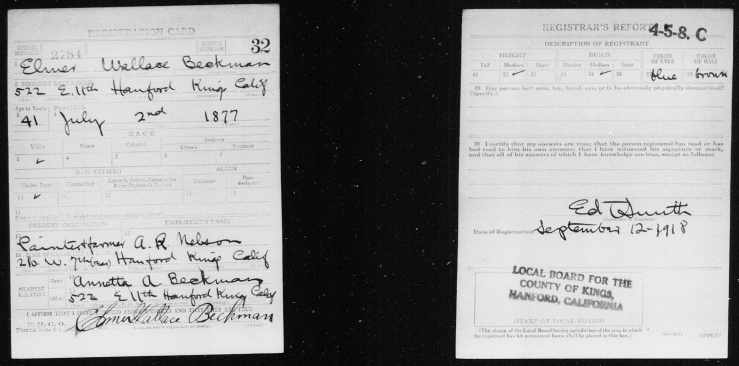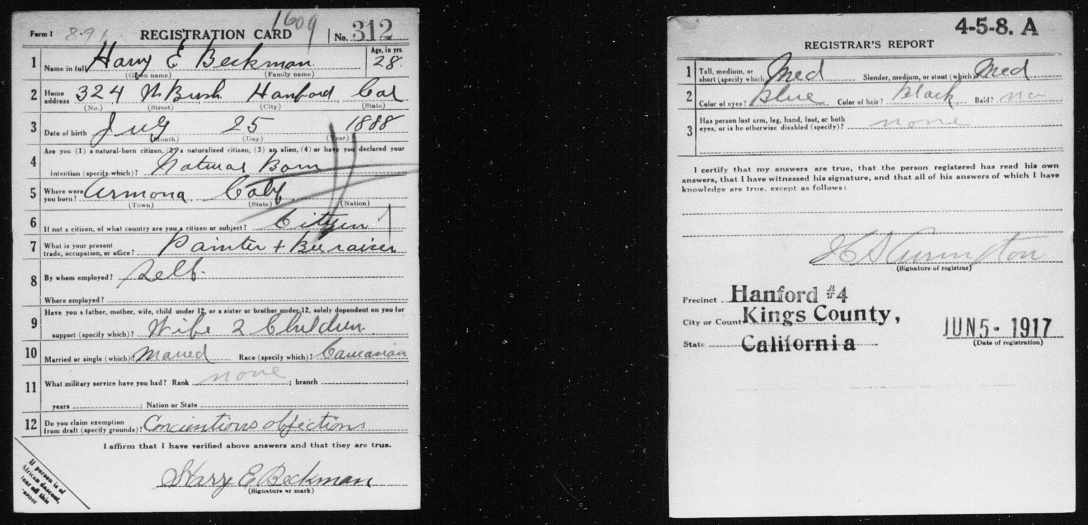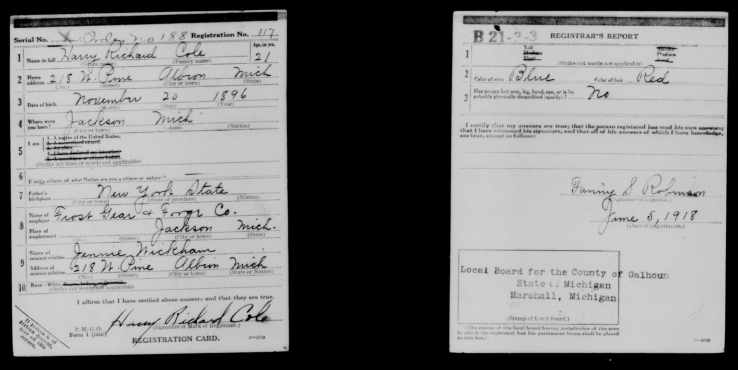One of my favorite sources is the World War I Draft Registration Card collection. These cards recorded information about many men living in the United States in 1917 and 1918. They record birth information, date and sometimes place, which can be difficult to find for this generation. These men were born when many states were not yet keeping birth records. These records also include a physical description of each person, which adds a dimension to family history. And if you are very lucky and have a male born between 6 June 1896 and 5 June 1897, you could get a father’s exact birthplace.
The FamilySearch Wiki has a good guide to the records under United States, World War I Draft Registration Cards (FamilySearch Historical Records). FamilySearch’s overview of these records:
Three registrations occurred between 1917 and 1918. The 1st was held 5 Jun 1917 for men ages 21-31. The 2nd was held 5 Jun 1918 for men who turned 21 since the 1st registration. The 3rd started 12 Sep 1918 for men ages 18-45. The collection includes cards for 24 million men. The cards are arranged by state, by city or county, by local draft board, then alphabetical by surname. The draft registration cards are part of Record Group 163, Records of the Selective Service System (WWI), 1917-1939, and is National Archives Microfilm publication M1509.
(source: https://familysearch.org/search/collection/1968530?collectionNameFilter=true : accessed 1 May 2017)
The records, including images, are free at FamilySearch. They are also on Ancestry, if you prefer to link them to your tree over there.
So again, there were three World War I draft registrations. Nominally they were for men with birthdays:
- 5 Jun 1886 to 5 Jun 1896 – Registration 1
- 6 Jun 1896 to 5 Jun 1897 – Registration 2
- 12 Sep 1873 to 4 Jun 1886 and 6 Jun 1898 to 12 Sep 1900 – Registration 3
Each of the three draft registrations used different cards with different questions. (Or at least they were supposed to. More on that later.) We will look at their differences below, but all registration cards have at least these fields:
- Full name
- Age in years
- Home address
- Date of birth
- Citizenship status
- Employer
- Place of employment
- Race
- Signature
- Height (tall, medium, or short)
- Build (slender, medium, or stout)
- Color of eyes
- Color of hair
- Any physical disabilities
- Registration date
- Registration board location
1st Registration

(source: “United States World War I Draft Registration Cards, 1917-1918,” database with images, FamilySearch.org (https://familysearch.org : accessed 1 May 2017), Harry E Beckman, no. 312, Draft Board 4, Hanford, Kings County, California, 5 Jun 1917; citing World War I Selective Service System Draft Registration Cards, 1917-1918, NARA microfilm publication M1509; FHL microfilm 1,530,797.)
In addition to the fields on all registration cards, records from the first registration include:
- Place of birth (town, state, and nation)
- Occupation
- Whether a family member depends on them for support (parent, sibling under 12, wife, or child under 12)
- Married or single
- Previous military service
- Whether claiming exemption from the draft, and on what grounds
2nd Registration
(source: “United States World War I Draft Registration Cards, 1917-1918,” database with images, FamilySearch.org (https://familysearch.org : accessed 1 May 2017), Harry Richard Cole, reg no. 117, order no. 118, Draft Board in Marshall, Calhoun County, Michigan, 5 Jun 1918; citing World War I Selective Service System Draft Registration Cards, 1917-1918, NARA microfilm publication M1509; FHL microfilm 1,675,071.)
In addition to the fields on all registration cards, records from the second registration include:
- Place of birth (city or town, state, and nation)
- Father’s place of birth (city or town, state, and nation)
- Nearest relative, name and address
3rd Registration

(source: “United States World War I Draft Registration Cards, 1917-1918,” database with images, FamilySearch.org (https://familysearch.org : accessed 1 May 2017), Elmer Wallace Beckman, serial no. 2784, order no. 32, Draft Board in Hanford, Kings County, California, 12 Sep 1918; citing World War I Selective Service System Draft Registration Cards, 1917-1918, NARA microfilm publication M1509; FHL microfilm 1,530,797.)
In addition to the fields on all registration cards, records from the third registration include:
- If a Native American, whether citizen or non-citizen
- Occupation
- Nearest relative, name and address
Things to be aware of when using these cards: I have seen 1st registration cards used for the 2nd registration and 2nd used for the 3rd. Maybe the office had several blank cards left over from the previous registration and didn’t want to waste them. I have seen a card where the answers to questions for the 2nd registration, like father’s birthplace, were written in on a card for the 1st registration. It is somewhat confusing as-is, but it makes more sense when you see a card from the 2nd registration.
World War I Draft Registration records are a great resource. They can be great evidence of birth information. This can be useful for lineage society applications, since many people on these cards did not have state birth records. This birth information is more contemporary to the birth than death, obituary, or headstone dates, and the individual more likely knew their own birth information compared to their spouses or children who often report it for them at their death. These records also often include the middle name, which may not be in other records.
Remember to also check records for siblings of your research subjects, especially when they themselves are not recorded. In the examples above, the individuals from the 1st and 3rd registrations, Elmer and Harry were brothers. Elmer’s card from the 3rd registration gives no information about his birthplace. Harry’s card from the 1st registration shows his birthplace, which shows where Elmer’s family was living when his brother was born.
Happy searching!




Liane,
I want to let you know that two of your blog posts are listed in today’s Genealogy Fab Finds post at http://janasgenealogyandfamilyhistory.blogspot.com/2017/05/janas-genealogy-fab-finds-for-may-5-2017.html
Have a great weekend!
LikeLike